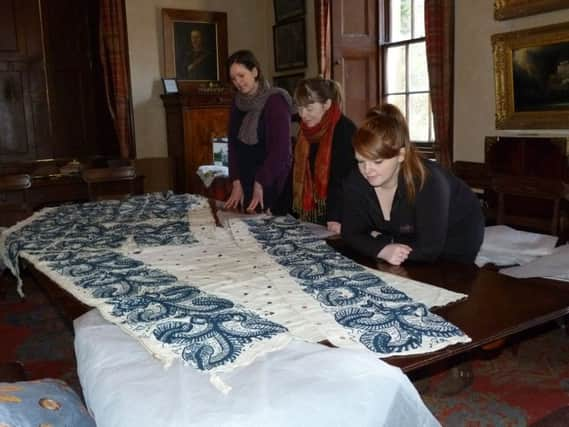Rare Jacobean bed linen found in ruined castle restoration


The rare embroidered linen was found inside a pillow case in the attic of Dunollie House, Oban, where the Clan MacDougall chief moved to from the adjacent castle in 1746.
While a £254,000 project begins to conserve the ageing structure of the ancient castle the linen, which once hung in the chief’s bedroom, has stood the test of time.
Advertisement
Hide AdAdvertisement
Hide AdJane Isaacson, sustainability and development manager for the Dunollie Projects team, said staff had been tidying up the attic when they made the discovery.
Ms Isaacson said: “There was lots of stuff in the attic and we were just tidying up when some of the team came across the pillow case.
“There was great excitement when we realised we had found the original castle bed hangings in the pillow case, it was extraordinary.
“I heard this squealing, a couple of the team came squealing down the stairs and said ‘look what we have found’. It is an amazing example, complete with Jacobean embroidery.”
Historian Catherine Gillies, who is an expert on Dunollie, said the bed hangings date from the 17th century.
She said: “These bed hangings are absolutely astounding, they are as rare as hens’ teeth and they have managed to survive.
“The designs are just beautiful, leaf and flower patterns interspersed with the most amazing red and blue spots. It looks so contemporary it could have stepped out of Laura Ashley.”
Advertisement
Hide AdAdvertisement
Hide AdShe added: “The bed hanging is made of linen and the embroidery is crewel work, it’s made out of wool which is dyed indigo.
“Indigo would only have come from the east, the most expensive colours at that time were red and blue and if you could afford blue you were rich.
“The blue hasn’t faded at all, it’s in fantastic condition.
“This is from the height of Jacobean Scotland’s cultural renaissance, the backing is unbleached linen and the pattern is embroidered on with wool.”
Mrs Gillies said there is documentary evidence, in an ancient inventory, which shows the bed hangings were the property of Iain Ciar, the 22nd Chief of Clan MacDougall, who fought in the Jacobite Rising of 1715. She added: “All sorts of people will have slept in that bed, any number of chiefs.”
The bed hangings will go on display this autumn and in the meantime specialist stone masons Heritage Consolidation are carrying out conservation work on the castle.
Ms Isaacson said the firm wanted to use as many local workers as they could and added: “They are removing ivy and stabilising the south facing outer walls. We want to get the safety fencing away so that visitors can get into the building.”